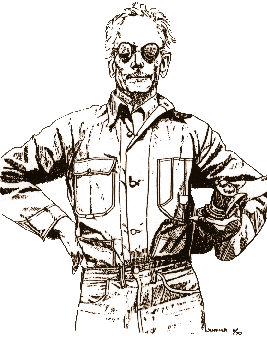Utah Centennial Studies

Hunt For the Blind Miner's Mine Packet B
The Story of The Blind Miner
James L. Newman, or Roy as he was called, was born October 4, 1893, in Holladay, a son of pioneer homesteaders of the area.
On a spring afternoon, April 8, 1929, Roy and his brother were mucking ore from rounds fired the previous day. There had been a misfire, and Roy said he thought he had better blast that miss before he quit for the day.
Somehow, he got mixed up with the cap in the hole and the charge blew up in his face. With a cut artery in his hand, face bleeding and sight gone, he staggered with the aid of his brother from the property near the old Maxfield Mine in Big Cottonwood Canyon.
 After
a year or so of inaction, Roy said he decided to go back to work on the
claims.
After
a year or so of inaction, Roy said he decided to go back to work on the
claims.
There were a few months at first when he hired a man to work with him, but gradually he learned to solve the many difficult problems facing the blind, particularly when they live alone.
"Even cooking becomes a task when you can't read the labels on the cans," he said.
Roy is a wonder to the mining engineering profession. As U.S. Mineral Surveyor Andrew R. Shelton, American Fork, relates, his tunnels have a perfect engineering grade for draining and haulage. They are so straight you can stand at the face of the tunnel and see the light of the portal.
Roy explains that he is able to drive such tunnels because although both my eyes were destroyed by the blast, a tiny area at the bottom of my left eye about a hall inch below the pupil was still intact although the rest is completely covered by scar tissue. "Through this small window, I get a faint sensation of light," he said. Thus when he checks the tunnel bore for straightness, he sets up a lighted carbide lamp in the middle of the track about 300 feet from the face.
"I then move up to within 15 feet of the lace and stand up a pick with handle erect in the center of the track. These two objects thus mark the center of the tunnel," he related.
Roy then backs up to the face, sights down the tunnel and then moves his body to the right or the left until the light is obscured by the pick handle. When this happens, he knows his head is in the center of the tunnel.
With this point located it is an easy matter to measure to the right or left to see if the face of the tunnel is on line.
He tells the difference between country rock and ore by weight and formation change by the ease with which the drill sinks into the rock.
Although without sight, Roy performed each task of mining including mucking, tramming, drilling, blasting, sharpening drill steel, laying rails on grade, keeping the tunnel in line and timbering.
Despite his apparent handicaps, Mr. Newman had the basic optimism all miners must possess. He believed the big bonanza was just ahead. "I like the challenge that Mother Nature presents the miner who searches for her secrets," he said.
But, for the last year, terminal cancer forced the miner to quit active mining and finally on April 1, 1974, he died. He was 80 years of age.

 UTAH EDUCATION NETWORK
UTAH EDUCATION NETWORK

 Justin
Justin Braxton
Braxton Dani
Dani Kayla
Kayla Katie
Katie Matthew
Matthew Rob
Rob Val
Val
